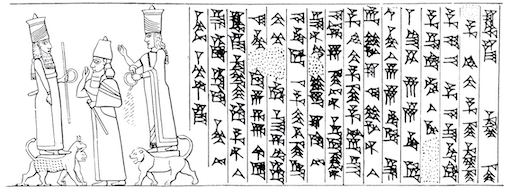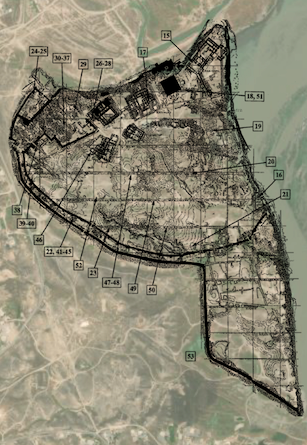You are seeing an unstyled version of this site. If this is because you are using an older web browser, we recommend that you upgrade to a modern, standards-compliant browser such as FireFox [http://www.getfirefox.com/], which is available free of charge for Windows, Mac and Linux.
Neo-Assyrian Archival Texts from Assur

Whereas the Assyrian heartland [https://www.ucl.ac.uk/sargon/essentials/countries/centralassyria/] otherwise stretches along the eastern bank of the Tigris, the ancient city of Assur (modern Qalat Sherqat) sits on a rocky outcrop on its western bank, controlling a useful ford over the river. At this well-protected position, the city is connected to the important overland route leading in western direction to the Khabur valley and further on to the Euphrates valley, and beyond that to the Mediterranean and Anatolia.

Depictions of the Assyrian state god Aššur from the time after Sennacherib's destruction of Babylon in 689 portray him as the master of the Babylonian god Marduk's powers too. In this new double role, Aššur is shown standing on two holy animals: his own traditional lion-dragon and Marduk's snake-dragon (mušhuššu). Sennacherib is praying before him. Detail of a rock relief at Maltai (also known as Halamat) above the city of Dohuk in Northern Iraq, near one of Sennacherib's irrigation projects. Photo by Karen Radner. View large image.
Assur is situated in a geo-ecological border situation where the favorable Mediterranean climate of the Assyrian heartland gives way to the arid steppe zone. The city was therefore a natural contact point with the pastoralists that made use of this dry region for grazing their sheep flocks. In the early second millennium, the city was a prominent participant in the long-distance trade of metals (especially tin) and luxury textiles. By means of inter-state treaties, Assur had at that time managed to establish permanent trading colonies (designated with the Assyrian term kārum, "harbor") at the city-states of Central Anatolia, most prominently at Kaneš (modern Kültepe).
Throughout its long and variegated history, Assur was the Assyrian religious, ideological, political and administrative center, the seat of the god Aššur and the place where the royal dynasty had its origins and its rulers their palace and burial place. However, in 879 BC, political power was moved away from Assur to Kalhu [/atae/kalhu/] (modern Nimrud, biblical Calah), the new capital city of Ashurnasirpal II [/riao/theassyrianempire883745bc/ashurnasirpalii/index.html] (r. 883–859 BC). In the imperial phase of Assyrian history, Assur's role is less prominent in the realm but as the only seat of the god Aššur, the city firmly retained its prominence as a religious center and its gods, temples and festivities continued to receive much royal interest.
The god Aššur, his temple and the city of Assur were the main beneficiaries when Sennacherib [/rinap/rinap3/] (r. 704–681 BC) began an ambitious program of religious and cultic reforms in the aftermath of his attack on Babylon in 689 BC, as the king sought to portray Aššur as the new master of all the powers formerly held by Marduk, lord of Babylon. At Assur, the god's ancient temple was renovated and rebuilt on a much larger scale, and the king ordered the creation of a new statue of the god, commemorated prominently also in the imagery of the newly crafted divine seal of Aššur that also shows the new statue of his consort Mullissu.

Hand-drawn facsimile of Sennacherib's seal. Reproduced from D.J. Wiseman, The Vassel-Treaties of Esarhaddon (= Iraq 20/1 [1958]) p. 16 Fig. 2.
The city of Assur was explored during the German excavations led by Walter Andrae from 1903-1914 who lived and worked there for over a decade with the help of a few assistants (usually trained architects like Andrae himself) and hundreds of local workmen. Today, the objects unearthed during these excavations are in the main in the Vorderasiatisches Museum in Berlin and in the Oriental Museum in Istanbul, as the finds were divided between the German Oriental Society that funded the work and the Ottoman authorities that controlled Iraq at that time. Iraqi teams have continued with the exploration of Assur, on and off since 1978, and there were also German excavations in 1990 [/atae/wvdog152/] and again 2000–01. The finds from these later digs are all kept in the Iraq Museum in Baghdad.

Satellite image of the ruins of Assur overlaid with a general plan of the archives and libraries (Pedersén, Archives and Libraries in the Ancient Near East 1500-300 B.C. p. 133 Plan 62). Image prepared by Jamie Novotny.
The aim of the Assur sub-project of ATAE is to make the published Neo-Assyrian archival texts from Qalat Sherqat available online for free in a fully searchable and richly annotated (lemmatized) format, as well as to widely disseminate, facilitate, and promote the active use of these important cuneiform sources in academia and beyond. ATAE/Assur presently includes Neo-Assyrian sources edited in the following publications:
- al-Rafidan 17 [/atae/rfdn17/] = A. Yaseen Ahmad, "The Archive of Aššur-mātu-taqqin Found in the New Town of Aššur and Dated Mainly by Post-canonical Eponyms," al-Rāfidān 17 (1996): 207–288;
- SAA 02 [/saao/saa02/] = S. Parpola and K. Watanabe, Neo-Assyrian Treaties and Loyalty Oaths (State Archives of Assyria 2), Helsinki 1988
- SAA 03 [/saao/saa03/] = A. Livingstone, Assyrian court poetry and literary miscellanea (State Archives of Assyria 3), Helsinki 1989
- SAA 12 [/saao/saa12/] = L. Kataja and R. Whiting, Grants, Decrees and Gifts of the Neo-Assyrian Period (State Archives of Assyria 12), Helsinki, 1995
- SAA 13 [/saao/saa13/] = S. Cole and P. Machinist, Letters from priests to kings Esarhaddon and Assurbanipal (State Archives of Assyria 13), Helsinki 1999
- SAA 20 [/saao/saa20/] = S. Parpola, Royal Rituals and Cultic Texts (State Archives of Assyria 20), Winona Lake, IN, 2017
- SAAB 5 [/atae/saab0509/] = F.M. Fales and L. Jakob-Rost, "Neo-Assyrian Texts from Assur: Private Archives in the Vorderasiatisches Museum of Berlin, Part 1," State Archives of Assyria Bulletin 5 (1991): 3–137
- SAAB 9 [/atae/saab0509/] = K. Deller, F.M. Fales, and L. Jakob-Rost, "Neo-Assyrian Texts from Assur: Private Archives in the Vorderasiatisches Museum of Berlin, Part 2," State Archives of Assyria Bulletin 9 (1995): 3–137
- SAAS 2 [/saao/saas2/] = A. R. Millard, The Eponyms of the Assyrian Empire 910-612 B.C. (State Archives of Assyria Studies 2), Helsinki 1994
- StAT 1 [/atae/stat1/] = K. Radner, Ein neuassyrisches Privatarchiv der Tempelgoldschmiede von Assur (Studien zu den Assur-Texten 1), Saarbrücken, 1992
- StAT 2 [/atae/stat2/] = V. Donbaz and S. Parpola, Neo-Assyrian Legal Texts in Istanbul (Studien zu den Assur-Texten 2), Saarbrücken, 2001;
- StAT 3 [/atae/stat3/] = B. Faist, Alltagstexte aus neuassyrischen Archiven und Bibliotheken der Stadt Assur (Studien zu den Assur-Texten 3), Wiesbaden, 2007
- WVDOG 152 [/atae/wvdog152/] = P.A. Miglus, K. Radner, and F.M. Stępniowski, Ausgrabungen in Assur: Wohnquartiere in der Weststadt, Teil I (Wissenschaftliche Veröffentlichungen der Deutschen Orient-Gesellschaft 152), Wiesbaden, 2016
Please note that work on some Assur sub-corpora is still in the early stages of preparation. The texts in al-Rafidan 17 [/atae/rfdn17/], SAAB 5 [/atae/saab0509/], and SAAB 9 [/atae/saab0509/] have not yet been not lemmatized (linguistically annotated). Please bear with us while we work on this material.
Click here [/atae/assur/pager] to visit the ATAE/Assur corpus.
ATAE is a key component of the Archival Texts of the Middle East in Antiquity (ATMEA) sub-project of the LMU-Munich-based Munich Open-access Cuneiform Corpus Initiative [https://www.en.ag.geschichte.uni-muenchen.de/research/mocci/index.html] (MOCCI; directed by Karen Radner and Jamie Novotny). Funding for the ATAE corpus project has been provided by LMU Munich and the Alexander von Humboldt Foundation (through the establishment of the Alexander von Humboldt Chair for Ancient History of the Near and Middle East).
For further details, see the "About the project" [/atae/abouttheproject/index.html] page.

Home Page banner credit
The ruins of the ziggurat of the Assyrian national god Aššur at Assur. Photo Credit: Karen Radner (24 February, 2022)
Karen Radner & Jamie Novotny
Karen Radner & Jamie Novotny, 'Neo-Assyrian Archival Texts from Assur', Neo-Assyrian Archival Texts from Assur, The ATAE/Assur Project, a sub-project of MOCCI, 2023 [http://oracc.org/atae/assur/]